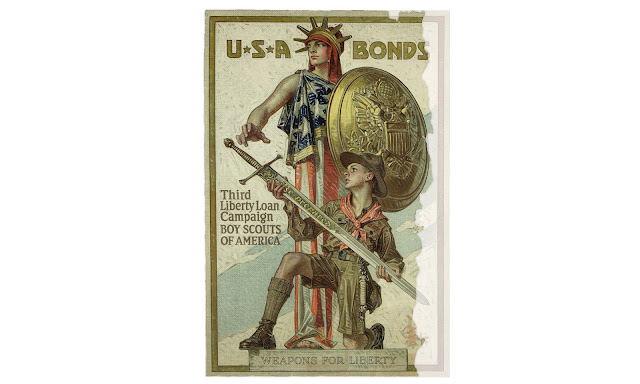 |
|
Weapons for Liberty, 1917
Joseph Leyendecker (German-born American, 1874-1951)
Paper; 35 x 25 ½ in.
96.41.5
Gift of Mr. and Mrs. Weston F. Sprague
|
Most everyone wants to be involved in something greater than themselves, and for many boys and young men in the United States it has historically been the Boy Scouts of America (BSA). On August 1, 1907, Robert Baden-Powell gathered 20 young boys together for a weeklong camping trip. This adventure evolved into the Scouting movement, which in turn came to the United States around 1910 as the BSA. Throughout the last century, the BSA has played an important role not only in the lives of many boys and men, but also in US political history. A journey through the early years of the BSA using objects from the Bowers Museum’s collections demonstrates the progression of the BSA, as well as the ways in which it linked American childhoods to the world of politics.
 |
|
Boy Scout Hat, 1937-1943
United States
Leather, grosgrain, and felt; 13 ¾ x 12 ¼ x 5 in.
96.36.905
Gift of the Fullerton Museum Center
|
When the United States entered World War I, the Scouts were immediately mobilized to assist with the war effort. The BSA’s best-known contribution was their involvement in the campaign to sell war bonds, loans to the government to help finance the war. The bonds sold by the United States government had previously only been purchased by financial institutions as a low-risk investment tactic rather than a display of patriotism. During World War I, however, the government promoted the purchase of bonds as a way for everyday citizens to support their country. Scouts were incentivized to sell to family, friends, and neighbors with buttons and medals, but for many it was a way to support a father who had left to fight on European soil. Whatever their motivation, by the end of the Great War Scouts had sold nearly $355 million in bonds. This advertisement, illustrated by Joseph Leyendecker, lionizes war bonds as “Weapons for Liberty,” with a young Scout offering Lady Liberty a sword engraved with the BSA’s then-new motto, “Be Prepared.” The sheen of patriotism applied to war bonds established the BSA as a patriotic organization, influencing its trajectory over the rest of the 20th century.
Our second object, an official uniform hat, was likely used between the late 1930s and early 40s. While hats might seem less overtly political than the sale of war bonds, the evolution of Scout hats mirrors that of headgear worn by the US Army. During the First World War, American soldiers and Scouts alike wore campaign hats like this one; visible too in the Leyendecker advertisement. This hat is missing the emblem which would have adorned its front, and the sharp “lemon squeezer” creases of a campaigner have come undone over time; but a ribbon with the Boy Scout fleur-de-lis, and an inner band made of leather and stamped with the BSA seal indicate for certain that this is a Boy Scout hat. To further reinforce the parallel, when the US entered World War II in 1941 the US Army officially switched to the garrison caps. The garrison cap was adopted by the BSA only two years later.
 |
|
Boy Scout Neckerchief, 1953
United States
Cloth; 18 ½ x 42 in.
76.7.5
Gift of Mr. William Lowe
|
 |
This patch indicates the owner of this neckerchief
was from the Jamboree's host region. Detail of 76.7.5. |
The third and final piece of this history provides a window onto the Boy Scout Jamboree of 1953, an event that shaped both the BSA and Orange County. This neckerchief, emblazoned with three official patches for the Jamboree and boasting two more indicating the wearer was a member of the Jamboree’s host region would have been an important part of a scout’s uniform for the event. Held on the Irvine ranch, the Jamboree brought almost 50,000 Scouts from all over the non-Communist world to Orange County for a five-day celebration of Scouting. The scale of the event was large enough to serve as an exposition of American ideals in a burgeoning age of Cold War tensions. An MGM film about the event shows boys of all ethnicities playing together at a time when segregation was still the norm in many parts of the US; Christian, Jewish, and Buddhist spiritual services were held alongside one another; even the Jamboree’s motto, “Forward on Liberty’s Team,” was picked to match the political moment. All-told the jamboree expressed the same message as the war bonds campaign: The Scouts were at the forefront of America’s team.
 |
| The neatly ordered rows of the 1953 Boy Scout Jamboree. Photo courtesy Orange County Archives. |
The history of the Boy Scouts of America is inseparable from that of the United States. What is particularly special about this history, however, is how deeply it is ingrained in Scout ephemera. The fact that both personal and political history are imprinted on these objects is what makes them so important. These are not only objects that shaped millions of childhoods – they also changed the history of a nation.
Text and images may be under copyright. Please contact Collection Department for permission to use. Information subject to change upon further research.





Comments 1
Very glad to see this positive Boy Scout history. My father was the first Eagle in our family. Now my grandsons are also Eagles, making us consecutive 4 generations of Eagles. The ideals of the Scout Law and the community service imbedded in scouting has helped to shape our family into responsible contributors to our society. Thank you for including.